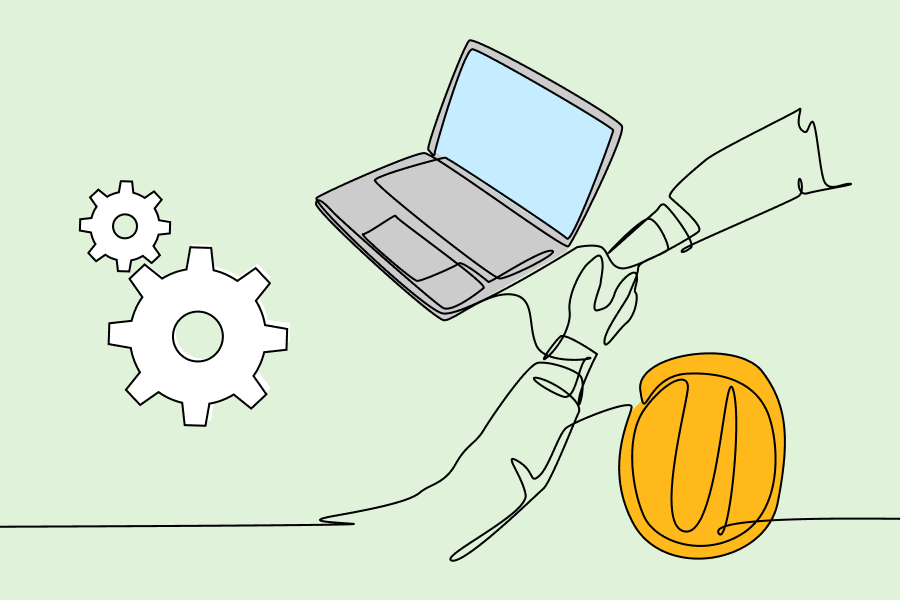The sudden shift to remote work during the COVID-19 pandemic has fast-tracked the move towards a digitally connected construction workforce. Many companies recognise the benefits of more flexible work arrangements as the economy opens up.
Balancing remote and in-office work will become the new normal for many industries and roles. One of the critical challenges of remote working every company will need to overcome is the potential isolation of remote employees from the broader team. One way companies can resolve these issues is through a hybrid work arrangement, offering employees the opportunity to work both from home and in the office.
What is a hybrid work model?
Hybrid work brings together employer, client and employee requirements. Rather than being dictated by location, the hybrid work model is human-led and benefits from attracting a more diverse talent pool.
Remote working focuses solely on remote access, while the hybrid model seeks to harness the advantages of both the onsite and offsite arrangements.
Traditionally, the opportunity to build valuable connections with co-workers and clients, workshop ideas and have casual conversations between meetings has been confined to the office. Technology is making it easier to move these activities into the virtual realm, with more robust chatting, video and collaboration software coming online all the time.
These tools, combined with new ideas and understanding of how work is performed, let companies tap into the broader valuable ad hoc conversations and information flow that happens informally in the physical workplace environment.
The hybrid environment also enables challenges around motivation, productivity and work visibility to be resolved alongside reducing the risk of exclusion or isolation from the broader team.
What does a hybrid work model in the construction industry look like?
Hybrid working arrangements are central to an employer’s offering and securing and retaining talented staff.
The hybrid work model is linked to better workers’ health and well-being, reduced commuting costs and often more focused time on completing tasks with fewer interruptions. People who participate in a hybrid working environment also have more freedom and autonomy over where and how they work — empowering them to showcase their full potential to employers.
For businesses, it means becoming more attractive to talent seeking flexibility. With fewer people in the office every day, your business could either introduce permanent social distancing solutions or even find a smaller, more economical office. It can improve productivity and loyalty of staff who no longer have to balance commuting with personal responsibilities, while also providing cost savings with fewer physical overheads.
Some people prefer the workplace environment, while others need the support and supervision an office environment provides. In the construction industry, many roles have to be delivered on-site. Among those roles that can be remote, such as marketing, administration, project planning and finance, the people who deliver those roles also need to fit the hybrid model.
Tips for setting up a hybrid work model in your construction business
Since the beginning of COVID-19, businesses have had to shift and react quickly to lockdowns and stay-at-home requirements. Now is the time to step back, assess and plan how to make long term use out of the hybrid work models you may have already developed.
Here are some tips to help you get started:
- Determine which roles or elements of roles can be delivered remotely more permanently. Work with your HR representatives and team leaders to define tasks and the appropriate amount of time that can be spent working away from the office.
- Be clear about how the hybrid model will work — develop policies and processes and identify requirements to define the working arrangements, such as flexibility in location and working hours.
- Develop the support mechanisms for both those who can take part in the hybrid offering and those who cannot — such as team communication with a mix of informal and formal meetings and ensuring remote staff have the right equipment. This arrangement may provide the impetus for improving communication across your teams and the broader business.
- Ensure your teams have the right software and tools to complete their tasks and collaborate effectively. Cloud-based software means all team members can access the latest information, and video-conferencing tools mean your team can meet face-to-face from anywhere at any time.
There is a significant risk in different versions of documents and data impacting project progression for construction teams. Tools such as Revu ensure all team members have real-time data and information about project progression and requirements, from design to construction to completion. Revu speeds up design reviews by allowing project partners to mark up documents and collaborate in real time. You can manage all your project folders and files in one location, so teams can easily access, upload and review the latest documents.
Hybrid working arrangements are here to stay and present businesses with the opportunity to become more agile in their overall functions and activities.
Think about how you can incorporate hybrid working models in your company and support your people in building longer-term solutions that will ensure productivity and connectivity.












